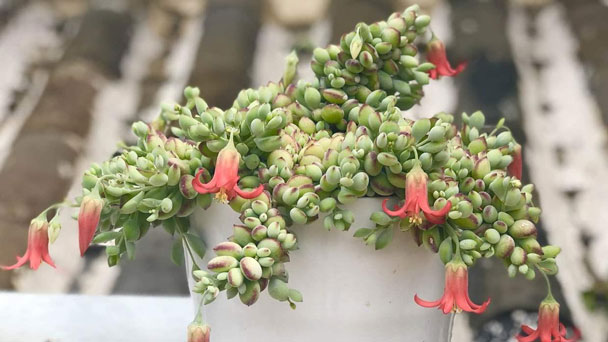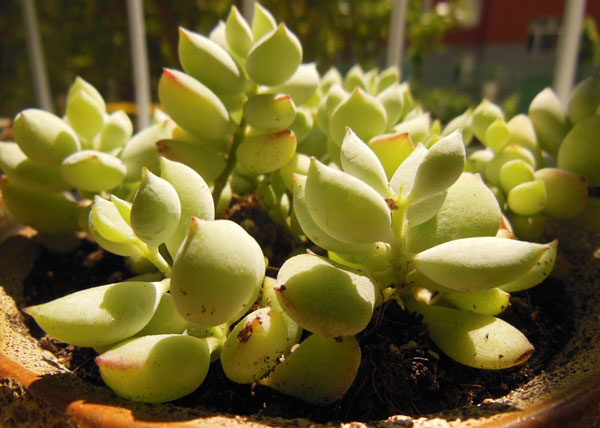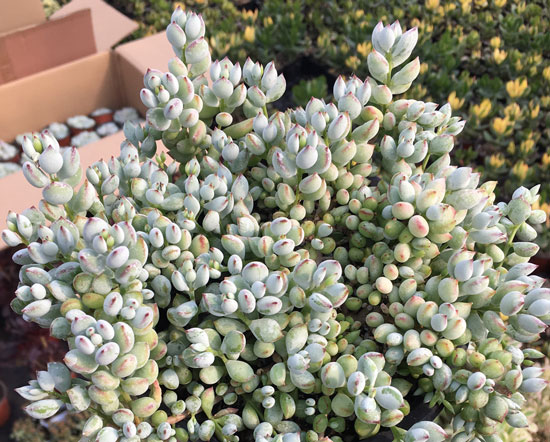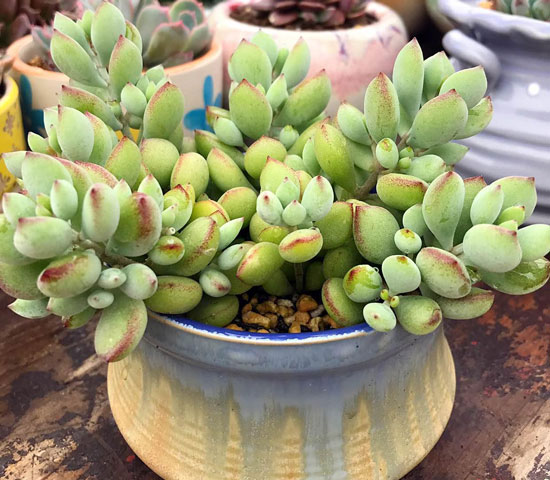Cotyledon Pendens (Cliff Cotyledon Succulent) Grow & Care Guide
Written by Iris
Nov 03 2021

Cotyledon Pendens (Cliff Cotyledon) is a succulent plant belonging to the genus Sedum. Although the leaves of Cotyledon Pendens (Cliff Cotyledon) are small, they grow very densely. The poles are very thin, so it is difficult to support the upward growth and will be full of creeping. It grows downwards, and Mofu Niang has a special fragrance, and many netizens say it is similar to an apple-like fragrance.
This type of succulent prefers a warm climate. It can survive at zone 10a-11b which is around -1.1°C (30°F). If you live in a cold area, it is better to plant cliff cotyledon in an indoor environment. As long as it gets enough sunlight, the plant will grow happily.
Most species of Cotyledon are quite adaptable and can grow in most types of container. Plastic, ceramic, and terra cotta pots are all good choices, and most gardeners have a preference. As long as their needs are met, Cotyledon can grow anywhere.
The most important feature of a pot to consider is drainage. Well-draining soil will do no good if there’s nowhere for the water to drain. Drainage holes are necessary in keeping Cotyledon happy and healthy.
The most common way this is propagated is by using rooted cuttings taken from the lower stem instead of offsets found closer to the base.
This gives you more control over how many plants there are given space restrictions. It also allows for easier propagation as it doesn’t require waiting for offset plants to mature.
This succulent requires six hours of full sun each day if growing outdoors (but can tolerate less without problems). Just make sure your pot gets enough natural light before placing it outside.
When placed indoors next to a sunny window, the Cotyledon Pendens will need to be rotated every few days so that all sides of the plant receive light.
If you are growing this succulent as a houseplant and it is in low-light conditions, you should consider using an artificial grow light for around 12 hours per day or more if needed.
The only time when too much indirect sun exposure may cause problems is during the winter months. This is because plants grown outside won’t get enough natural sunlight due to changes in daylight duration (and thus length).
To create such soil in a pot, you should mix a balanced amount of sand with soil. This will make the soil well-draining. After that, you should lay a layer of pumice and perlite in the pot and put all your soil above it. You should add mulch and compost to make your soil nutrient-rich. You can also add fertilizer to the soil as well. This would help boost the growth of your plant from the initial stages. After creating the right mixture, you should pour it into the pot above the layer of pumice and perlite. Pumice and perlite would help stop the wastage of soil and will only allow the water to escape.
Some species of Cotyledon handle extreme heat better than others, so if you live in a place where it gets extremely hot in the summer, you should consider researching the specific species of Cotyledon you’re interested in to make sure it can handle living outdoors.The Cotyledon Pendens do well in high humidity areas. About 40% of humidity is good enough. If you are in a dry area you might have to use a humidifier. When the air is too dry, the plants stop growing.
The succulents can withstand frost-free cool temperatures during winter. However, they have to be kept dry and minimal watering if any.
The plant is not only poisonous but also dangerous to animals. The toxicity also affects other animals including goats and pigs.
Where to Grow Cotyledon Pendens (Cliff Cotyledon)How to Grow Cotyledon Pendens (Cliff Cotyledon)Cotyledon Pendens Propagation with SeedsCotyledon Pendens Propagation with Stem CuttingsCotyledon Pendens Propagation with OffsetsHow to Care for Cotyledon Pendens (Cliff Cotyledon)Cliff Cotyledon Lighting RequirementsCliff Cotyledon Soil CareCliff Cotyledon WateringCliff Cotyledon Temperature & Humidity CareCliff Cotyledon Fertilizer CareCliff Cotyledon PruningCliff Cotyledon Pests & DiseasesCotyledon Pendens (Cliff Cotyledon) FAQIs Cotyledon Pendens Poisonous to Cats and Dogs?Are cotyledon pendens rare?How fast does cotyledon pendens grow?
Where to Grow Cotyledon Pendens (Cliff Cotyledon)
Cotyledon Pendens ‘Cliff Cotyledon’ succulents need strong light. When planting this succulent type in a garden, make sure it gets sunlight. Full to partial sun is the best for its growth. It is better to grow outdoor rather than indoor.This type of succulent prefers a warm climate. It can survive at zone 10a-11b which is around -1.1°C (30°F). If you live in a cold area, it is better to plant cliff cotyledon in an indoor environment. As long as it gets enough sunlight, the plant will grow happily.
Most species of Cotyledon are quite adaptable and can grow in most types of container. Plastic, ceramic, and terra cotta pots are all good choices, and most gardeners have a preference. As long as their needs are met, Cotyledon can grow anywhere.
The most important feature of a pot to consider is drainage. Well-draining soil will do no good if there’s nowhere for the water to drain. Drainage holes are necessary in keeping Cotyledon happy and healthy.

How to Grow Cotyledon Pendens (Cliff Cotyledon)
Cotyledon Pendens Propagation with Seeds
This succulent type is a slow grower so even if it can be propagated by its seeds, this method is not recommended. To propagate Cotyledon Pendens from the seeds, plant the seeds in a well-draining soil mixture. This method can be used outdoors. In cooler areas, indoor propagating is recommended.Cotyledon Pendens Propagation with Stem Cuttings
Growing cuttings is an easy method that can be done at any stage of growth and will result in some variation of plant form.The most common way this is propagated is by using rooted cuttings taken from the lower stem instead of offsets found closer to the base.
This gives you more control over how many plants there are given space restrictions. It also allows for easier propagation as it doesn’t require waiting for offset plants to mature.
- Cut a stem from the lower section of the plant
- Slice off all but four leaves at the end near where you cut it, and remove any flower stalks. (This ensures that your cutting has enough water when starting out)
- Make sure not to damage any part of the cotyledon pendens root system on either side, as this will make for an unsuccessful propagation attempt.
- Place in a well-draining soil mix with full sun exposure or grow lights indoors
- The most common time for success is between November through March. Its native habitat and temperate weather conditions are changing during those months.
Cotyledon Pendens Propagation with Offsets
The Cotyledon Pendens Cliff Cotyledon can be propagated in several different ways. Still, the most common methods are by removing offsets from the base or stem and planting them in cacti soil. The roots will form on their own if given time.- Take an offset off the root clustered base with your fingers
- Remove any old leaves that may be compromising water retention
- Soak it for 15 minutes before planting to aid in seedling emergence
- Plant rooted offsets about two inches deep and keep at least one inch between each plantlet (If planted too close together, they can hinder growth)
- Allow to dry before watering
- Water on a weekly basis (more if in extreme drought)

How to Care for Cotyledon Pendens (Cliff Cotyledon)
Cliff Cotyledon Lighting Requirements
The Cotyledon Pendens needs good bright light, but it does not need to be in direct sunlight. The plant will grow well with indirect sun exposure from an east or west-facing window. The ideal location would have bright but filtered light conditions, as long as this still allows some air movement through the leaves when you are spraying them with water.This succulent requires six hours of full sun each day if growing outdoors (but can tolerate less without problems). Just make sure your pot gets enough natural light before placing it outside.
When placed indoors next to a sunny window, the Cotyledon Pendens will need to be rotated every few days so that all sides of the plant receive light.
If you are growing this succulent as a houseplant and it is in low-light conditions, you should consider using an artificial grow light for around 12 hours per day or more if needed.
The only time when too much indirect sun exposure may cause problems is during the winter months. This is because plants grown outside won’t get enough natural sunlight due to changes in daylight duration (and thus length).
Cliff Cotyledon Soil Care
The Cliff Cotyledon succulent plant needs soil that does not trap water in it for a long time. They need the soil to quickly drain the excessive water. Because excessive water that will be trapped in the soil will keep their roots wet all the time. This is bad for their roots, as they need to remain partially dry. Otherwise, root rotting will destroy the roots of your plant. To protect your plant, you should plant it in soil that is well-draining and does not trap water in it for the long term. Apart from this, your soil should also contain all the basic nutrients for the plant's growth. If your soil does not contain elements required for the growth. The cliff cotyledon succulent plants would grow very slow and might die soon.To create such soil in a pot, you should mix a balanced amount of sand with soil. This will make the soil well-draining. After that, you should lay a layer of pumice and perlite in the pot and put all your soil above it. You should add mulch and compost to make your soil nutrient-rich. You can also add fertilizer to the soil as well. This would help boost the growth of your plant from the initial stages. After creating the right mixture, you should pour it into the pot above the layer of pumice and perlite. Pumice and perlite would help stop the wastage of soil and will only allow the water to escape.
Cliff Cotyledon Watering
Like all the other succulents, Cotyledon pendens is a very dry-tolerant plant that requires less water. So, water it occasionally to infrequently and be careful of overwatering. Water when soil is dry to the touch and stop watering during dormancy.
Cliff Cotyledon Temperature & Humidity Care
If you live in a climate where temperatures regularly dip below freezing, you won’t be able to keep Cotyledon outdoors year-round. This is not a frost tolerant genus of plants, so if you experience cold winters, you can expect to bring your Cotyledon indoors for the winter.Some species of Cotyledon handle extreme heat better than others, so if you live in a place where it gets extremely hot in the summer, you should consider researching the specific species of Cotyledon you’re interested in to make sure it can handle living outdoors.The Cotyledon Pendens do well in high humidity areas. About 40% of humidity is good enough. If you are in a dry area you might have to use a humidifier. When the air is too dry, the plants stop growing.
The succulents can withstand frost-free cool temperatures during winter. However, they have to be kept dry and minimal watering if any.
Cliff Cotyledon Fertilizer Care
The Cliff cotyledon succulent needs nutrients from the soil to grow. But the soil only has a limited supply of nutrients in it that are quickly depleted after planting the Cliff Cotyledon Succulent. Once these reserves are depleted, you will need to feed your plant fertilizers to provide nutrients. Otherwise, its growth would slow down and can also stop in severe cases. You should check the soil for nutrients deficiency and find the best succulent plant fertilizer for your plant. You should feed this fertilizer to your plant through water, or by direct mixing of fertilizer with the soil.Cliff Cotyledon Pruning
The Cliff Cotyledon Succulent grows a lot of branches, leaves, offsets, and flowers. These need to be trimmed properly to control the spread of your plant and give it a proper shape. Pruning of the Cliff Cotyledon Succulent should be done during the spring season. You can take a sharp cutter and cut all the extra parts, leaves, offsets, branches, and dead parts of the plant as well.Cliff Cotyledon Pests & Diseases
The plants can get mealy bugs and it can be difficult to save the Cotyledon Pendens especially when they get a full-blown infestation. The plants have so many little crevices and nodes and the pests hide in them. Make it a habit to check the plant every time you’re watering. Pests can be controlled with neem oil. If the pests have multiplied too much, you might need to use a stronger pesticide.
Cotyledon Pendens (Cliff Cotyledon) FAQ
Is Cotyledon Pendens Poisonous to Cats and Dogs?
Cotyledon plants including Cotyledon Pendens are toxic to cats or dogs. The plants contain toxins or poisonous sap.The plant is not only poisonous but also dangerous to animals. The toxicity also affects other animals including goats and pigs.
Are cotyledon pendens rare?
Cotyledon pendens is a rare succulent shrublet with hanging branches and flowers, only known from sheer cliff faces along the Bashe River in the Eastern Cape (former Transkei region).How fast does cotyledon pendens grow?
In about three weeks, roots will form on the leaf and a new plant will develop at the base. For the propagation from seeds, sow seeds in summer 2-3 mm deep and space them closely to grow as a mat. Germination time is about 3 weeks.Latest Updated
- Benefits of Bugleweed - 7 Science-backed Health Benefits
- Bugleweed Dangers & Side Effects - Is It Poisonous?
- How to Plant Evergreen Trees - What You Should Know
- When to Plant Evergreens - Grow Guide for Evergreen Trees
- 12 Wonderful Evergreen Shrubs for Your Garden
- 12 Popular Evergreen Plants with Pictures for Beginners
- When And How To Prune A Lilac Bush Like a Pro
- How to Grow & Care for Lilac Vine (Hardenbergia Violacea)
- Japanese Lilac Tree (Syringa Reticulata) Care & Propagation Guide
- Shumard Oak Pros and Cons - What to Know
Popular Articles
- Winter maintenance of Antirrhinum Majus
- How to Grow Terminalia Mantaly Tree
- How to Grow and Care for Crossostephium Chinense
- How to grow Antirrhinum Majus in spring
- Peristeria Elata (Dove Orchid) Profile: Info & Care Guide
- Underwatered Snake Plant (Sansevieria Trifasciata) - Signs And How To Fix
- How to Care for Brazilian Jasmine Plant (Mandevilla Sanderi)
- How to Grow & Care for Graptopetalum Purple Delight in Summer
- Rosa Chinensis (China Rose): Plant Growing & Care Tips
- How to Care for Baby Sun Rose (Aptenia Cordifolia)